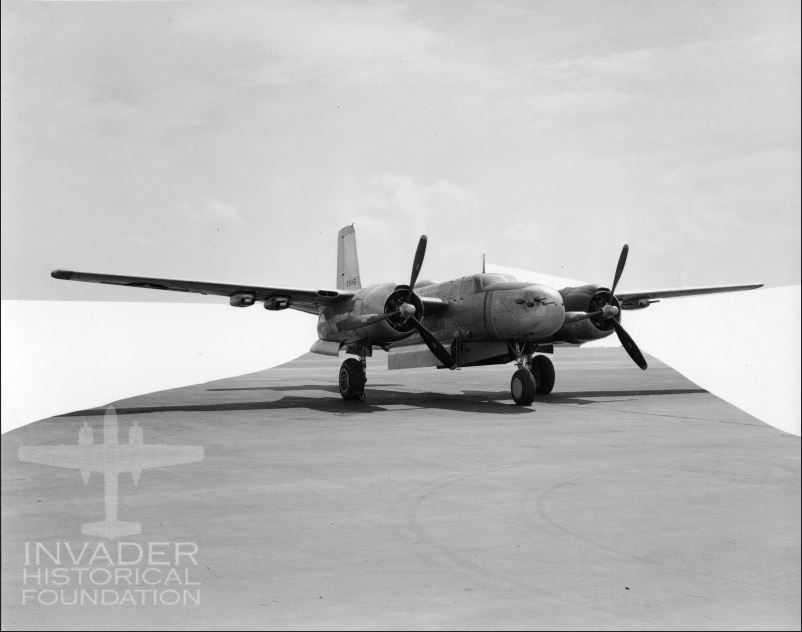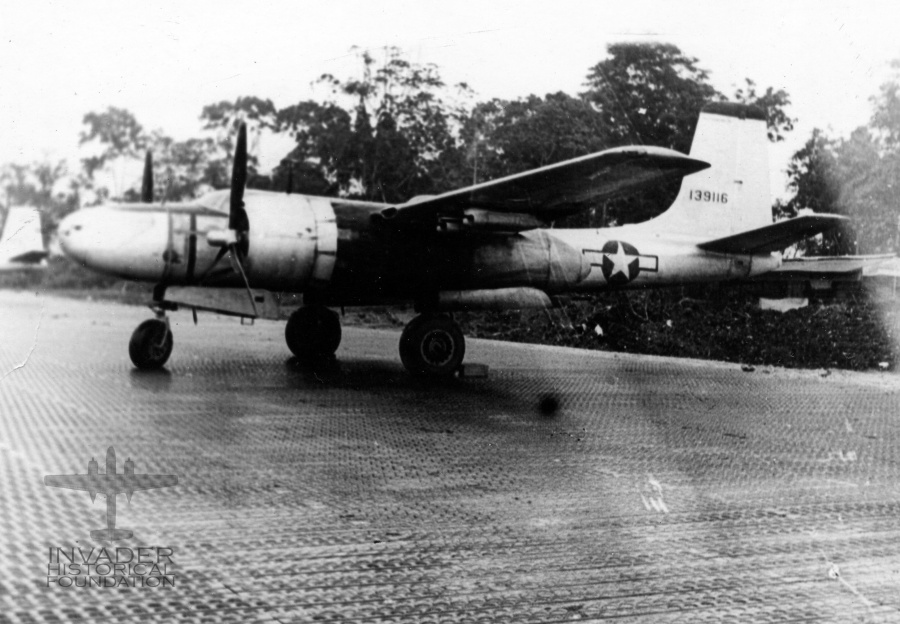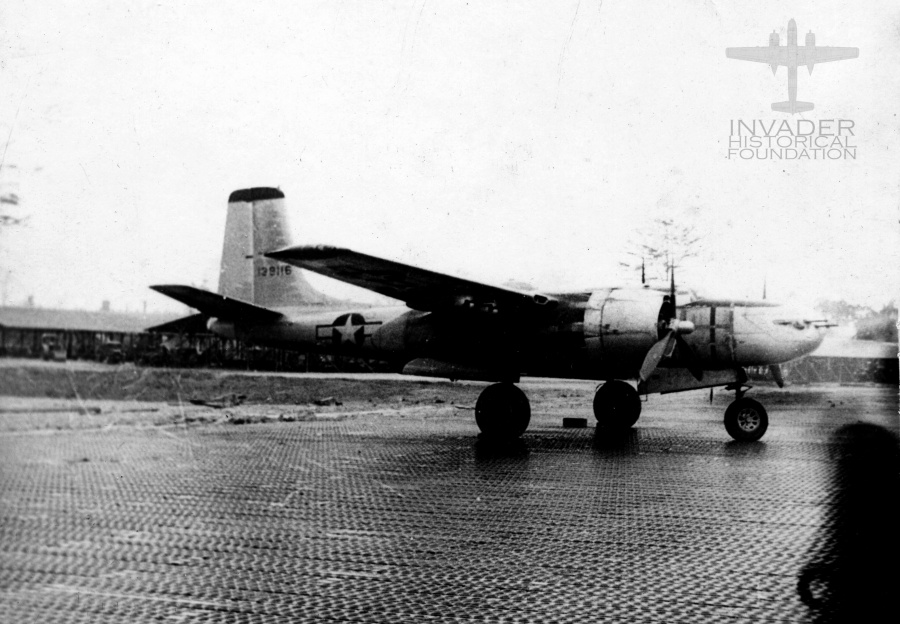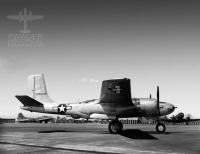41-39116
| A-26B-5 Invader | |||
|---|---|---|---|
| Builders: Douglas Aircraft Company | |||
| Operators: United States Air Force | |||
| Number Built: 30 (15-DT, 15-DL) | |||
| First Built: Dec 1943 | |||
| GENERAL CHARACTERISTICS | |||
| Type: Light Attack Bomber | |||
| Wet Weight: 31,000 lb | |||
| Length: 50' 9" (with guns) 49' 11" (without guns) | |||
| Height: 18' 6" (5.64 m) | |||
| Wingspan: 70' (21.34 m) | |||
| Wing Area: 540 Sq. Feet (50.17 m²) | |||
| Speed: 212 mph | |||
| Max Speed: 370 mph | |||
| Ceiling: 31,300 feet (6,700 m) | |||
| Powerplant: 2x Pratt & Whitney R-2800-27 | |||
| Horsepower: 2,000 each | |||
| Fuel Capacity: 1,600 US Gallons 125 Gallon tank in bomb bay | |||
| Range: | |||
| Crew: 2 | |||
| Passengers: 1 | |||
| ARMAMENT | |||
| Nose Guns: 1x 75mm Cannon | |||
| Dorsal Turret: 2x .50 Machine Guns | |||
| Ventral Turret: 2x .50 Machine Guns | |||
| Payload: 4,000 lbs internal 2,000 lbs wing points | |||
| Donate | |||
| Donate | |||
| Even a small donation of a couple of dollars goes a long way in helping | |||
See also: List of Invaders by Serial Number
In his book A-26 Invader Units of WW 2 (Pg. 91), Jim Roeder states about the planes sent to the 3rd Bomb Group for testing:
"No photographs of the A-26s used by the 3rd BG for the combat evaluation undertaken in June 1944 are known to exist. It is reported that they were flown in olive drab and neutral grey camouflage."
This is incorrect. The production notes show that the A-26B-1-DT model was painted as Jim describes above. However, one of the changes listed on the production notes for the A-26B-5-DT is the "deletion of camouflage". This is further supported by photographic evidence. Jim stated that no photos existed, but I have images of 41-39116, 41-39117, & 41-39118 during their combat trials at Zadnab. All of those planes are unfinished aluminum, not Olive Drab. These images confirm the data in the production note changes listed by Douglas.
One thing that is of note is that the production records for the A-26B-5-DL block indicate that it was built with the 75mm cannon in the nose. This block includes planes between serial numbers 41-39105 through 41-39119. Of these, we know for certain that 41-39105 and 41-39108 had 75mm cannons. This plane should also have a 75mm cannon due to the production block, but the cannon was too heavy to ferry. The nose armament was removed during transport and 6x .50 caliber machine guns were installed once it arrived at Nazdab.
Operational History
It was received by the USAAF Feb 1944
Delivered Long Beach to NAS Alameda, CA. Dismantled for shipping.
6 May 1944 Departed Oakland, CA for delivery to Finschhafen, New Guinea. Assembled and flown to Nadzab, New Guinea. 3rd Bomb Group, Hollandia, New Guinea.
Jun 1944 - Combat evaluation with 13th Bomb Squadron, 3rd Bomb Group
25 Jul 1945 - Declared obsolete and abandoned overseas.
Accidents
No Accidents listed
Crew
Unknown
Disposition
Unknown
Stories
From Bill Rupert, 13th Bomb Squadron Pilot:
"Just finished reading Bob Mosley's recollections of the two A-26s that arrived at Hollandia in summer 1944 and thought I would pass on my remembrance.
To lay a little groundwork I must tell you about the rudder pedals on the A-20. They were mounted at an angle with the top being further towards the nose than the bottom. The brakes were applied by pressing on the top of the pedals. Over a period of time I had got into the habit of sliding my feet up high on the pedals while on the approach so that I was ready to use the brakes immediately if necessary. It became such a habit that I would not even be conscious of it.
Then I got my check ride in the A-26. Takeoff was fine and the handling in the air was ok except that that I didn't like those engines restricting my view and the aircraft just had a, for want of a better word, heavy feel. My vote was for the A-20.
Anyhow, on the approach I unconsciously slide my feet up high on the rudder pedals. It did not register that these pedals were in a vertical position so that when I touched down I had the brakes on. Immediately blew both main gear tires and by the time I got it stopped, had ruined the wheels. Well, naturally, since no idiot was ever expected to ruin wheels, there were no spares. I don't know how they did it but the mechanics modified a couple of B-25 wheels to use and it continued flying. I don't think I need tell you that I was not invited to take any more A-26 rides.
I do know that they continued to accompany the A-20s on missions and the pilots I remember talking to did not particularly like them."
Images
41-39116 pictured at the air field in New Guinea. It is sporting wheels from a B-25 after pilot Bill Rupert blew the tires on a landing during a test flight.

41-39116 on the runway during combat trials with the 13th Bombardment Squadron in the Pacific.

41-39116 at Nadzab Field during combat trials with the 13th Bombardment Squadron in the Pacific in 1944. The tail of 41-39118 is just visible on the left edge of the first photo.


Sources
Databases searched:
- AAIR - No Entry
- MACR - No Entry
- KORWALD - No Entry
- Baugher


